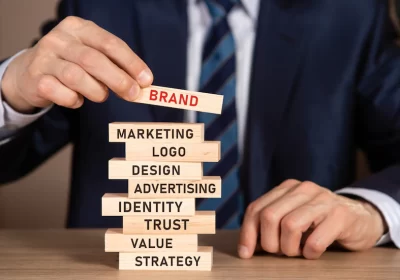What Is Brand Identity? Learn About Different Elements That Build A Brand Identity
Imagine that your company is a person.
They wear a funky hoodie, cargo pants, and a golden chain around their neck. Now, imagine another company as a person who wears a tuxedo.
While looking at both, you build a perception of both of these persons (brands) through different elements that represent them. This is all the term brand identity is about.
You can simplify the term brand identity as a perception. It is what a viewer or an audience makes out of your brand by looking at it. It is normal to make mistakes between several other terms like ‘brand image’ or ‘branding.’ But they are different.
What Is Brand Identity?

We distinguish between people by understanding how they walk, talk, dress, and communicate socially.
They are communicating verbally and visually to establish a certain identity that people perceive them as. Brand identity is almost the same.
A company’s brand identity includes its choices of words and other visual elements that communicate its personality to its audience. The company’s visual elements, voice, and tone all transpire to build its personality to the audience.
This identity helps the brand stand apart from the crowd of competition and become distinguishable. With a strong brand identity, the target audiences can recognize the brand from a mere glimpse of it. Here are the core elements of a brand identity –
- Brand visuals, logs, colors, layouts, fonts, and design materials like photography and illustration.
- The tone and voice of the brand include a slogan, social, email, tagline, ad copy, in-product content messaging, and website copy.
Read More: Ethics In Business: Definition, Principles, Why They’re Important?
How To Build Strong Brand Identity?

Yes, I did put a lot of emphasis on the elements of the brand right there. But that does not make these elements the only thing that builds a brand’s identity. It starts with who a brand is trying to become and who it is. Who a brand is and who they are trying to be comprises a few questions and elements. Why don’t you ask your brand these questions?
Define What Your Brand Is About
- What is your brand’s mission? (Ask your brand why you are doing what you are doing.)
- What are the brand’s values? (What beliefs drive the brand?)
- What would your brand look like if it were a person?
- What differentiates your brand from the others? (How do you separate yourself from other brands?)
- What is the brand’s voice, and who does it communicate to?
These are some of the elements that determine the brand identity of your company. Once you understand the answer to all of these questions, you better understand your brand. Now you can communicate with the audience to whom you are trying to sell your product or services.
Well, it might seem too hard for you to try and do this. But these are not too difficult; all you might need is some brainstorming.
Ask yourself some of these below mentioned simple questions –
- Why are you doing the business in the first place?
- What beliefs and values are important to your business?
- What makes your business unique?
- What does your business do better than any other business out there?
- What would those three words be that describe your business?
Developing a brand identity is not easy. Your branding strategies need to be consistent to build a brand. But first, you must understand who your brand is and what it can transform into.
So, first, try to identify what your brand is about. Then you can move to other more important aspects like design and more.
Design: The Foundation That Builds Perception
Once you personify your business, you are ready to build upon that persona you have readied. You need solid design work to visualize your brand’s identity or personality. So, it is crucial for you to build different design assets that visually develop your brand’s personality.
These elements include your logo, packaging, web design, and social media presence across different social media platforms. Even the business cards and the employees’ uniforms are significant emblems of your brand.
Let me make it simpler for you. Once you understand what your brand is about and can visually communicate that to your target audience, that’s something we call nailing your brand identity.
But this nailing part is not that easy. You need to do well at both content and design if you want to nail your brand’s identity. It can start with something like the font of your brand’s website.
Fonts
You need to choose your brand’s typography very wisely if you want to set up the right brand identity for your brand. There are hundreds of different types of fonts. But which one suits your brand’s voice? Hold it right there. How about I trip it down to only four different major options for you? Sounds fine!
Let’s check out these four major font styles –
Serif Fonts
We all know the OG Times New Roman, right? This font gives tiny-looking anchors at the end of each of the corners of the letters. It is one of the classics when it comes to typography. If you are trying to make your brand appear trustworthy and traditional or old school, then this is the font your brand needs.
Let’s move away from the traditional touch of Serif fonts, shall we? Sans serif is a font without the foot of the Serif font. While the Serif fonts have an anchor, the Sans Serif is more sleek and modern in its looks. If your audience is more of a modern millennial, then this stylish yet simple and sleek font will communicate the language of your brand.
Script Typography
Now, let’s jump into a different part of storytelling. Does your brand cater product to female customers? Is it a women’s fashion brand, or are you creating content on lifestyle topics? In that case, you can add the Script typography to do its magic. This font is great for adding a feminine or cursive feel to your brand.
Colors
Colors can speak to people. They can affect your audience psychologically. If you use colors with your brand and brand logos strategically, it will have a significant impact on your audience’s minds.
But first, you need to understand a color’s language or emotion. There are the fundamental colors of the rainbow, with a few more added to the list. However, you must choose the right color or color combination when you are communicating your brand identity with the audience. Here are different sets of colors and the general emotions they convey –
Red: Red is a color that shows a strong passion and excitement. If your brand’s identity is youthful, loud, and exciting in nature, then communicate with your target audience by choosing your brand’s color as Red.
Orange: If your brand’s personality is more playful and friendly with lots of high energy, go for orange. Sometimes, it gets used alongside Red and helps a brand stand out in the crowd.
Yellow: This color gives a cheerful vibe to the audience. If you are communicating fun, affordable, and accessible energy with your target audience, yellow might be your brand identity color.
Green: green is a versatile color that works for almost any other type of brand. Usually, when people see the color green, they think of money or nature. Does your brand deal with any of those? If yes, you have got the color that communicates your brand identity.
Blue: When conveying a brand’s trustworthiness, stability, and reliability, blue is the universal communicator. It is a collar used across different types of brands. Also, this color communicates to a wide variety of audiences. So, if you are targeting a wide demographic, and you want them to trust your brand for a long-term business, then blue is your brand’s color.
Purple: Purple is a royal color. Does your brand sell luxurious items? Or do you want to go with a luxurious feel on your brand? Either way, purple is the right color to use for your brand identity in that case.
Pink: Pink has become traditionally a color that most women adore. But it does not necessarily mean that only women should wear pink. However, if you follow some popular cosmetic brands, Avon Glossier NYX cosmetics are some of the popular female cosmetic brands that use the color pink for their branding. So, if your brand is about any products related to women, it can be a good decision to choose pink as the color for your brand’s identity.
Brown: Brown, as a color for a brand’s identity, is not often used. However, it does not hurt to stand apart from the crowd and do something different for a change. The color brown gives a rugged look to your brand. If you are selling trekking shoes, you can definitely have the rugged feel of the color brown in your products.
Black: Black is modern, classic, and sophisticated at the same time. It is one of those colors that some of the biggest brands in the world use for their brand identity. It has a sense of authority that big brands display through the use of this color.
Shapes/Forms
Once you have your typography and colors figured out, you are ready to convey your brand’s personality to your audience. But, the brand identity still lacks one thing – shapes.
Your logo, along with the colors and the typography, needs a shape that conveys the brand’s personality more clearly.
The shapes provide a subtle effect that goes a long way toward defining what a brand is all about. They help your targeted audience react to your brand’s personality in your desired way.
For example, a logo inside a circle will spark a different reaction in your audience’s mind than a logo inside a sleek square shape. If you are up for learning more about how shapes define logos, then go through the section below –
Round Shapes: When you have round, circular, or oval-shaped elements with your logo, they share a warm and friendly message with the target audience. These shapes can communicate the feeling of building a community, love, or unity. Sometimes, the round edges of your brand’s logo can also express feminine nature.
Straight Shapes: square, straight-edged, or rectangular shapes help brands communicate feelings of efficiency and strength. The Straight or sharp-edged shapes can be rigid and, hence, need to be handled with care. They must be balanced with other round or oval shapes and friendly colors to create a dynamic brand identity.
Lines can have various implications and play a big part in conveying your brand’s stories. Vertical lines can suggest masculinity, while horizontal lines can convey a more mellow or tranquil vibe. Once you understand what effect your brand’s identity creates in your target audience, you can choose between different types of lines as visual elements for the brand’s voice.
So, these are more or less the primary elements you need to finalize to create your brand identity. When you have decided upon all of these building blocks of the brand’s identity, you should look for a professional designer and work with them to build your brand’s presence.
Read More: Leadership Ethics: Why Is It Important, And How Can It Affect An Organization?
Final Words
The nature of your business is detrimental to how you choose and use different design elements to build your brand identity. You can use different numbers of design elements to convey your brand’s personality. For example, if you have a physical store or restaurant, you need to pay more attention to building your storefront. But, a SaaS product or an online service provider will think more about how their website and social media page looks to the audience.
Your business logos, website, email templates, and product packaging all of them contribute to building your brand identity. Now that you know about brand identity, will you be able to build it for your brand? What are the most crucial elements you need to build your brand’s identity? Hopefully, this article will be helpful. Please let us know about any queries you may have regarding setting your brand identity.
Read Also:



